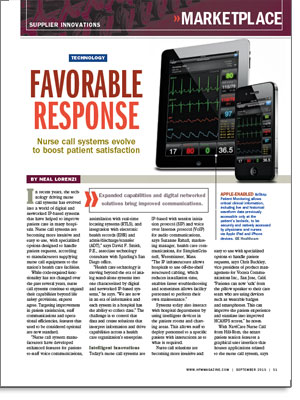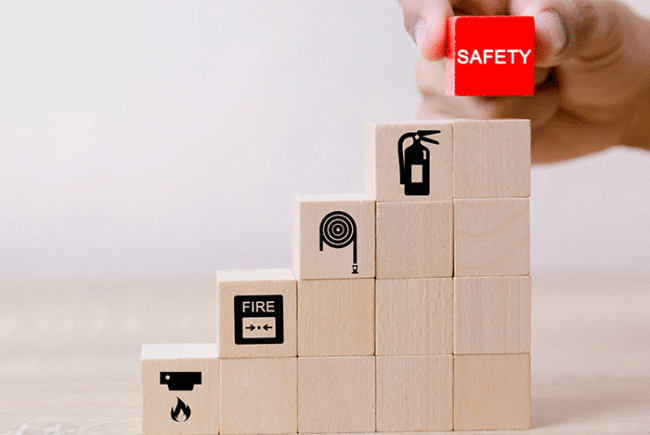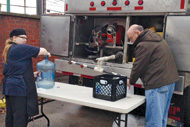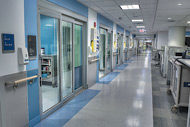
In recent years, the technology driving nurse call systems has evolved into a world of digital and networked IP-based systems that have helped to improve patient care in many hospitals. Nurse call systems are becoming more intuitive and easy to use, with specialized options designed to handle patient requests, according to manufacturers supplying nurse call equipment to the nation's health care facilities.
While code-required functionality has not changed over the past several years, nurse call systems continue to expand their capabilities beyond life safety provisions, experts agree. Targeting improvement in patient satisfaction, staff communications and operational efficiencies, features that used to be considered optional are now standard.
"Nurse call system manufacturers have developed enhanced features for patient-to-staff voice communications, assimilation with real-time locating systems (RTLS), and integration with electronic health records (EHR) and admit/discharge/transfer (ADT)," says David F. Smith, P.E., associate technology consultant with Sparling's San Diego office.
"Health care technology is moving beyond the era of analog stand-alone systems into one characterized by digital and networked IP-based systems," he says. "We are now in an era of information and each system in a hospital has the ability to collect data." The challenge is to control that data and create solutions that interpret information and drive capabilities across a health care organization's enterprise.
Intelligent innovations
Today's nurse call systems are IP-based with session initiation protocol (SIP) and voice over Internet protocol (VoIP) for audio communications, says Suzanne Rahall, marketing manager, health care communications, for SimplexGrinnell, Westminster, Mass. "The IP infrastructure allows hospitals to use off-the-shelf structured cabling, which reduces installation time, enables faster troubleshooting and sometimes allows facility personnel to perform their own maintenance."
Systems today also interact with hospital departments by using intelligent devices in the patient rooms and charting areas. This allows staff to deploy personnel to a specific patient with instructions as to what is required.
Nurse call solutions are becoming more intuitive and easy to use with specialized options to handle patient requests, says Chris Buckley, vice president of product management for Vocera Communications Inc., San Jose, Calif. "Patients can now 'talk' from the pillow speaker to their care team who are using devices such as wearable badges and smartphones. This can improve the patient experience and translate into improved HCAHPS scores," he notes.
With NaviCare Nurse Call from Hill-Rom, the smart patient station features a graphical user interface that houses applications related to the nurse call system, says Adam McMullin, vice president and general manager, Hill-Rom IT Solutions, Batesville, Ind. "These applications give hospital employees the ability to locate and call other staff members; place a staff emergency, normal or Code Blue call; update workflow status; and initiate requests."
In addition, the system includes a status board application, which is viewable on any PC on the hospital's network, he adds. The status board, often displayed on a large flat-screen monitor near the nurse's station, displays the status of the bed, patient information and location information. This enables floor staff and unit clerks to ascertain the location of peers and the safety of the patient's environment.
The CareBoard, from WestCom Nurse Call Systems Inc., Fairfield, Calif., is designed to keep the lines of communication open between staff and patients. Installed inside each patient's room, it ties into the nurse call system and offers such features as call assurance. In addition, it can be customized to meet each facility's needs. "It boosts staff efficiency and keeps patients informed during their stay by communicating important reminders, updates, current requests and general information to assigned staff," says Larry Peters, founder and CEO.
Systems integration
The integration of nurse call systems with other data and communication systems is a key development in the evolution of this technology, experts agree. This includes linking up with RTLS. "Integration and interoperability are key," says Buckley. "The nurse call solution must include both workflow and staff assignment capabilities. In addition, the ability to integrate with SIP telephony and secure messaging systems is very important."
This type of integration continues to evolve, says Rahall. "It started 20 years ago with pocket pagers, but today integration is with hospital information systems (HIS), telemetry equipment and smartphones. RTLS integration is almost a necessity in new installations. The biggest current development is integration of nurse call systems with EHR providers," she notes.
The latest nurse call systems are able to gather information and connect to patient monitors, alarm management systems, beds and other IT systems to enhance the efficiency of notifications, experts say. "More mobility platforms and alarm management systems are leveraging the staff assignment modules in nurse call systems to identify where to route important alerts and alarms. In some environments, calls may be cancelled remotely," says Ellen Street, general manager for monitoring solutions, GE Healthcare, Milwaukee.
A very popular trend in this area is SIP wireless phone integration, which allows routing patient calls directly to their assigned caregiver's wireless phone, says Myles Cochran, director of marketing, Jeron Electronic Systems Inc., Chicago.
The company's Provider 790 SIP wireless phone integration functionality includes:
Team nursing assignments and rollover. Caregivers are assigned to receive calls only from their patients. If the first caregiver cannot respond, the call automatically routes to the next caregiver in the team.
Facilitywide alerting and mobile communications. Patient calls route over the facility's LAN to the assigned caregiver's wireless SIP phone. Mobile caregivers can answer their patients' calls from any location within the LAN coverage area.
Patient call information. The caregiver's phone display includes the room number, bed and call priority for patient-initiated calls.
Remote service requirement setting. After determining their patients' needs, caregivers can set a service requirement to dispatch a team member to respond to the patient in person.
With the medical community moving to electronic health records, integration with other data and communication systems is a key development, according to Peters. "The request to integrate nurse call solutions to other hospital systems is now mandatory. Manufacturers are requested by hospitals on almost every installation to integrate with their new or existing communication systems to share data and have a single point of entry," he notes.
Smith says the integration of nurse call systems with RTLS is an exciting trend. "While some manufacturers claim to feature an open platform for interfacing with any RTLS manufacturer, others have developed strategic business alliances with RTLS manufacturers and offer their combined solutions as turnkey," he says.
Handheld abilities
Interfacing nurse call systems with handheld devices is a key trend, experts agree. "Connecting nurse call systems to handheld communications is absolutely the direction that health care is moving today as clinicians are more mobile, and there is increased focus on enabling them to spend more time at the bedside," says Street.
Hill-Rom's NaviCare Nurse Call has the ability to send calls and alerts to a caregiver's wireless phone. "For example, if a patient places a call, that call can be directly routed to his or her assigned caregiver, who can accept the call, speak to the patient, or reject the call and have the escalation procedures automatically route the call to the next person in the queue," says McMullin.
The challenge facing nurse call system vendors is how to take this to the next level, according to Smith. "Certain patients are inclined to avoid the nurse-assist button — similar to pressing a flight attendant call button on an airplane. The more user-friendly this interface can become, the better the patient satisfaction scores." Smith says Sparling is working with clients to implement a videoconference feature via the patient television screen that will allow caregivers to respond quickly and have face-to-face interaction without entering the patient room.
Buying and training
Hospital facilities professionals must deal with various purchasing and training issues when selecting and installing nurse call systems. "Consolidation is everywhere in health care and the biggest changes that we see in purchasing flow from that," says Larry Ball, director of marketing for Rauland-Borg Healthcare, Mount Prospect, Ill. "As hospitals consolidate, they have greater interest in standardization on such clinical systems as nurse call solutions. We work with centralized purchasing far more today than we did in the past."
When purchasing a nurse call solution, the facilities professional must make sure there is both a clinical champion and an IT champion on board early in the design phase, advises Buckley. "Having the right infrastructure in place is important, but equally important is the process change and design associated with the new technology. The call system should enhance workflow, not slow it down."
There are more possibilities of remote troubleshooting and even fixing certain problems today, which makes self-maintenance attractive to facilities managers, according to Rahall. At the same time, this can add more responsibility to an already over-taxed department. "As the systems become more IP-focused, ownership within the facility seems to be shifting to IT and telecom groups," she notes. "Because there is so much integration, more departments are called upon to assist in the prepurchase, installation, training and maintenance of the integrated communications solution."
Evolving regulations
The regulatory landscape also is evolving, especially in the area of assisted living, and standards have been updated to cover wireless devices, experts say.
"The regulatory environment for nurse call has changed a great deal in recent years," says Ball. "Some manufacturers that provide more advanced integrations are now treated as medical device suppliers by the Food and Drug Administration (FDA)." While this does not impact smaller manufacturers, it has forced many changes for larger suppliers that now must register their products and comply with quality process requirements of the FDA.
"New standards have been developed by Underwriters Laboratories (UL) and manufacturers to provide a minimum level of performance in assisted living residences, which currently have no regulatory requirements," says J.J. Johnson, CEO, Cornell Communications Inc., Milwaukee. "UL 2560, Emergency Call Systems for Assisted Living and Independent Living Facilities, was developed for this market." Introduced in 2011, the UL 2560 standard was driven by industry to address special communication challenges outside the hospital.
"The newest priority in senior housing is being able to locate residents when they call for help from outside their residence. Current technology solutions are available and require the addition of receivers to pinpoint the location, which can be very costly," Johnson notes.
According to Smith, the UL 1069 and UL 2560 standards now cover wireless devices for various components of nurse call systems. "A wireless system is attractive for any retrofit application or any facility that expects to repurpose spaces. Another sensitive regulatory issue with respect to nurse call systems is HIPAA compliance. This will continue to grow as an issue as more medical systems venture out into the public and into smartphones," he says.
Neal Lorenzi is a freelance writer based in Mundelein, Ill., who regularly contributes to Health Facilities Management.
| Sidebar - For more information |
| For further details on the nurse call systems featured in this month's Marketplace article, contact the following vendors: »Cornell Communications »GE Healthcare »Hill-Rom IT Solutions »Jeron Electronic Systems Inc. »Rauland-Borg Healthcare »SimplexGrinnell »Vocera »West-Com Nurse Call Systems Inc. |





